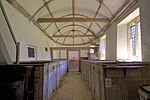Winterborne Muston
Dorset geography stubsVillages in Dorset

Winterborne Muston is a village in Dorset, England. The first name of "Winterborne" comes from the River Winterborne, which flows from west to east through the village. The river only flows overground during the winter, hence the name. To the west is Winterborne Kingston and to the east is Anderson. The river flows through both these villages as well.
Excerpt from the Wikipedia article Winterborne Muston (License: CC BY-SA 3.0, Authors, Images).Winterborne Muston
Muston Lane,
Geographical coordinates (GPS) Address Nearby Places Show on map
Geographical coordinates (GPS)
| Latitude | Longitude |
|---|---|
| N 50.777 ° | E -2.183 ° |
Address
Muston Lane
Muston Lane
DT11 9BU , Winterborne Kingston
England, United Kingdom
Open on Google Maps







